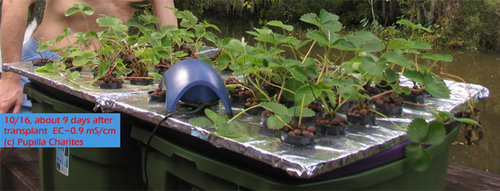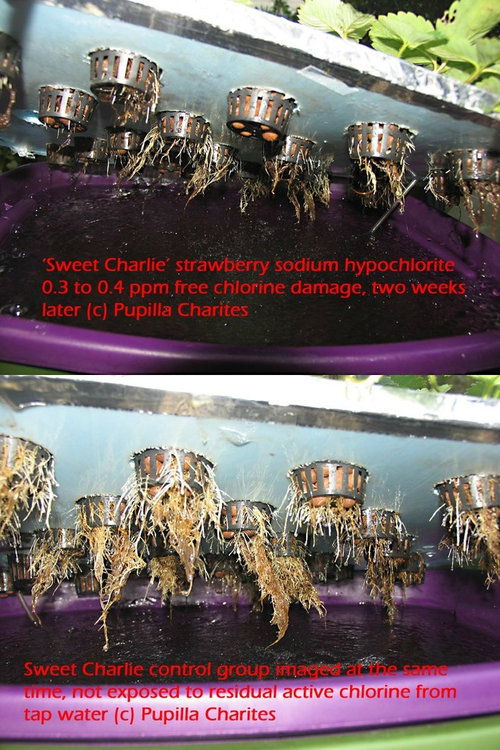strawberry winter trials dwc and nft
I'd like to share my strawberry trial which started with transferring 'Sweet Charlie' strawberries from plugs to a DWC nursery for the young plants.
The idea is to run dual nursery tubs and experiment by making changes in one to get ideas that work better, and as soon as new roots formed, long enough to transfer them into an NFT rig.
DWC is clearly not a preferred method for strawberries and this so far has re-enforced that in a practical way for me. If you can put them directly in an NFT, great! The goal to start NFT is to get the original dirt grown roots from the plugs to reach the channel, and some people cut the disks out of the net pot bottoms and pop them in that way. Others raise the level in the channel with dams for a temporary sort of RDWC in the channels until the dams are removed. I didn't want to do either, but both approaches have issues to deal with.
Whenever I come across a problem I thought I'd share it here in case someone else can benefit since I have appreciated comments from other kind members here which were very helpful.
On September 18 I got my plugs, 49 in all. They were supposed to be pathogen free, but that was not the case. Two fungus types can be noticed on the leaves, though they are strong plants and the pathogens are not obvious in the euphoria of getting live plants of your favorite variety even if they are flattened and somewhat smashed;-). We'll meet both fungi later though.

Due to incessant rains and not being able to get outside, I had to hold the plugs for 3 weeks before transplanting into the nurseries. During that time, I mistreated them by drying them out too much due to inattention and then when outside in the rain to stay acclimatized, they were too humid in a cycle that alternated in extremes with the humidity. They just about used up all the room and fertilizer in their flat and three died by drying out beyond recovery.
Finally they could get the earth removed and be put into 2" net pots with hydroton as the support medium. I chose two inches because it was Grizzman's favorite size and he gets many plants to work in it. Strawberries develop huge root systems when florishing and 3" or 3.5 inches is much more commonly used.
9 days after transplant, they hit their best point. The nutrient formulation was completely custom made and I started them on a 50% EC of my recipe.

pH was maintained somewhat acidic, at about 5.8. The thought was as the very dense planting (about 23 per res - lots of plants and a relatively weak solution), the pH would rise and I wouldn't have to adjust it for a while setting my adjustment only if pH hit 5.6 or 6.9. The plants continued to look stronger for a few days after the above picture, but hadn't moved from pH 5.8.
Within a week a lot of drizzle fell causing initial fungal contamination of a few of the healthy leaves. It was time for a res change which was done on #2 (left side) first. The first test was planned, to keep the formula the same but replace some sulfur with silicon at 12 ppm for that element.
The result was a second variable into this res during this change of 10/25: a careless preparation of the water by skipping a reasonable period of time for dechlorination.
Strawberries are extra sensitive to root damage from chlorinated water. Here is a 50/50 mixture of rain water with chlorinated municipal water (my town uses sodium hypochlorite, i.e., normal household bleach) and the free chlorine concentration is about 0.8 ppm, making this 50/50 dilution under 0.4 ppm of 'chlorination'.
It only sat about 2 hours in the afternoon before the plants started swimming in it, and the reaction was immediate, vigorous plants to the last man and girl quickly wilted and look suddenly like the poop was beat from them in res #2.
#2 was dealt a setback of approximately one month, due to the chlorination. The plants fell back to worse than they were upon transplant negating the excellent growth for three weeks and they did not pick up growing for about 10 days.

The picture is comparing two reservoirs of identical setups, about two weeks after the deed was done. The upper picture was has the insufficiently de-chlorinated water, and the lower water that sat out three days, covered at night and during the day sometimes with new Saran wrap (PE) and stirred once in a while. During the time the sunlight radiated directly in, I uncovered it and mixed it up a bit.
If you have a spare pump or airstone, this is a good time to use it, principaly working better when the sunlight is penetrating. Only 1/16 of the effective UV solar radiation penetrates to the bottom of of 2 foot deep res.
It is principally the sunlight that accelerates the speed at which chlorine is deactivated, and a temperature ramp helps, in addition to 'solarizing' it: for every 10 degrees F it warms, the available chlorine neutralizes itself about twice as fast. This is not the same reaction rate rule of thumb in chemistry - that's a doubling for 10 degrees Centigrade, but in the case it is twice that rate (quadruples for 10 C increase). Two days at 70 F is fine, even if one is somewhat overcast.
Meanwhile in res #1, I decided to leave the nutrient solution (16.3 gallons per res) for a full month since they were doing great so far and I wanted to prepare the water with time. At this point both reservoirs were attacked by a few individual Southern Armyworms (Spodoptera eridania).

Whether I plant peas or strawberries, this is the number one foliage pest by a lot, an incredibly wide spectrum of veggies host it, in this area and throughout a lot of the South. Other similar relatives are the Fall Armyworm -has for black dots on one end on upper back) and Beet Armyworm --usually a more light green which stays on the belly and gets a black back as it matures.
If you don't get it quickly, it decimates leaves, especially young and newly emerging growth. Plus, it provides fungi perfect places to spawn on the attacked leaves.
The armyworms are one reason it is hard to get motivated to put anything tender outside to grow!
This post was edited by PupillaCharites on Tue, Nov 12, 13 at 22:35







KarlVDH
PupillaCharitesOriginal Author
Related Professionals
Grand Haven Landscape Architects & Landscape Designers · Port Royal Landscape Architects & Landscape Designers · South Elgin Landscape Architects & Landscape Designers · Pelham Landscape Contractors · Wake Forest Landscape Contractors · Deerfield Beach Landscape Contractors · Eureka Landscape Contractors · Mesa Landscape Contractors · Pleasant Prairie Landscape Contractors · Quincy Landscape Contractors · Ringwood Landscape Contractors · Selden Landscape Contractors · Wareham Landscape Contractors · Westchester Landscape Contractors · Wheat Ridge Landscape ContractorsPupillaCharitesOriginal Author
grizzman
PupillaCharitesOriginal Author
PupillaCharitesOriginal Author
artgardenllc
PupillaCharitesOriginal Author
PupillaCharitesOriginal Author
PupillaCharitesOriginal Author